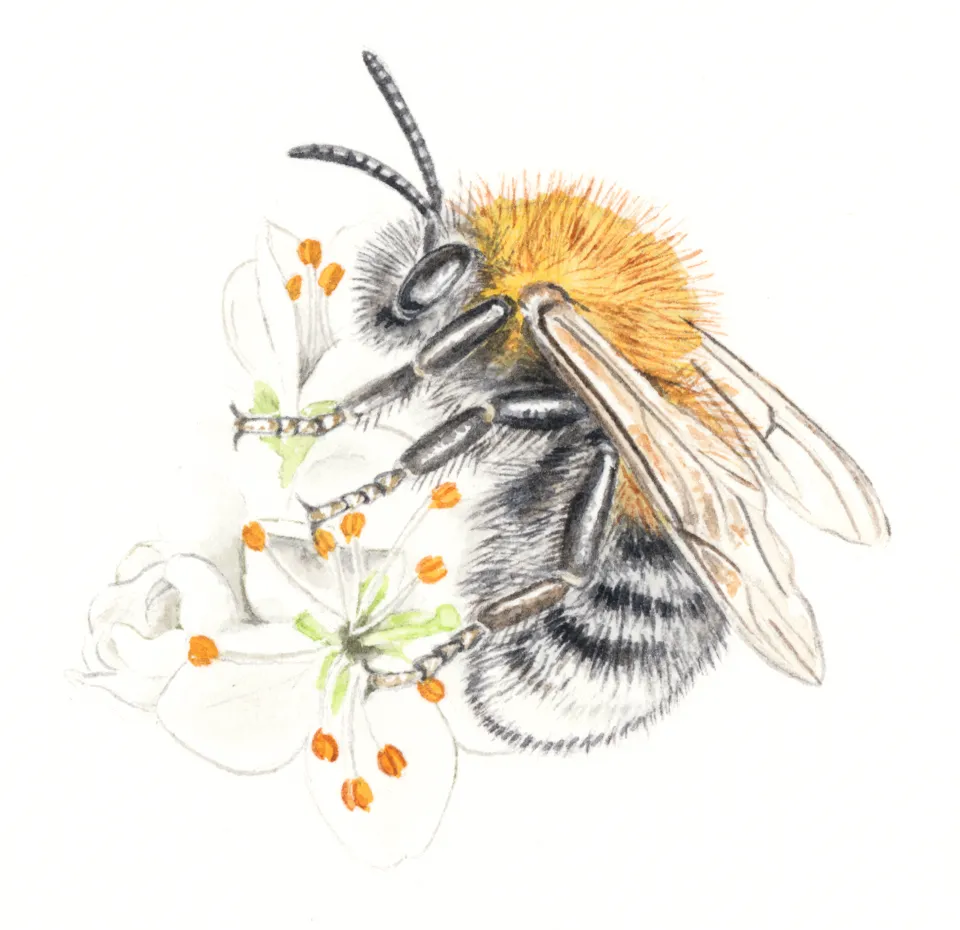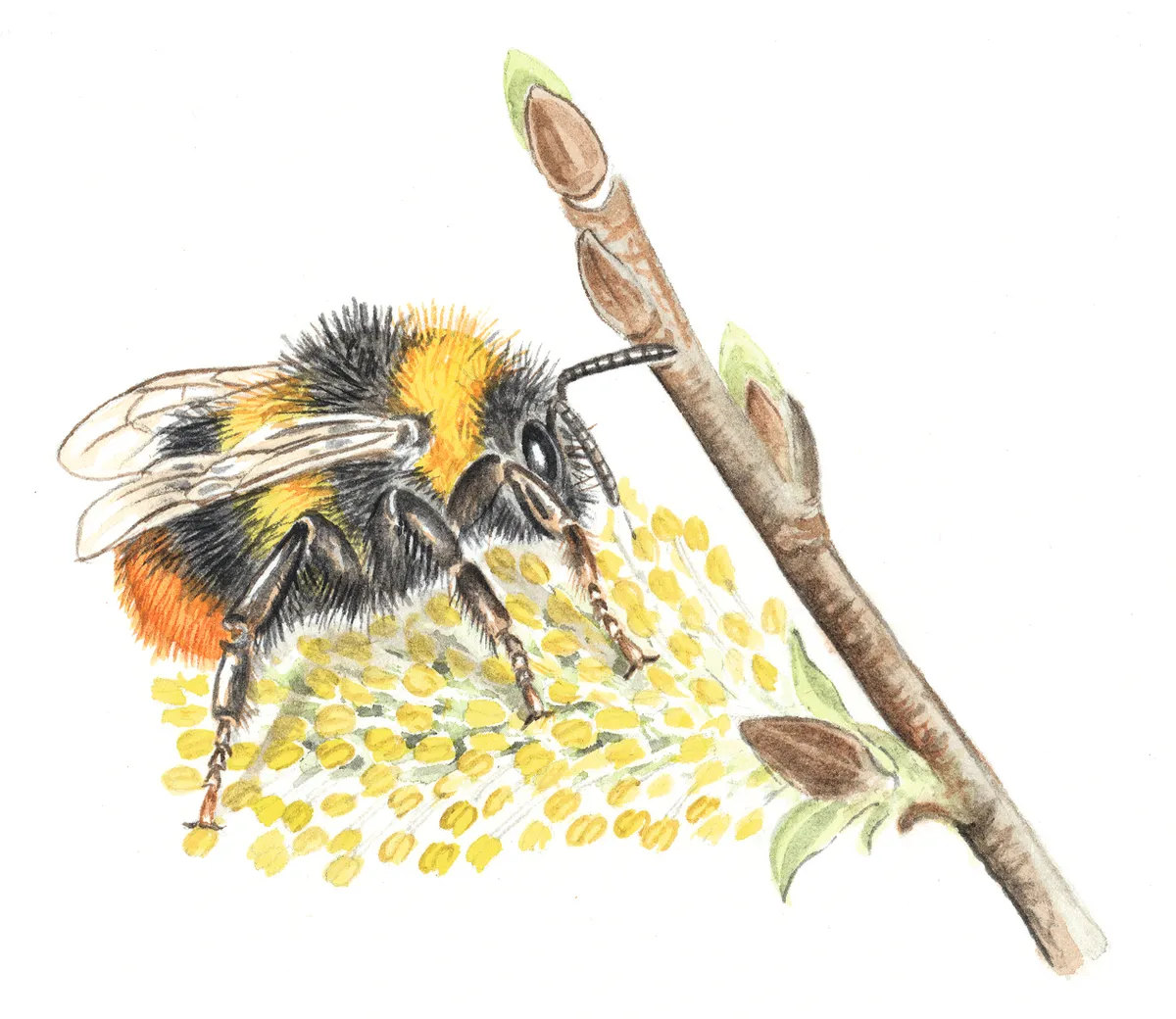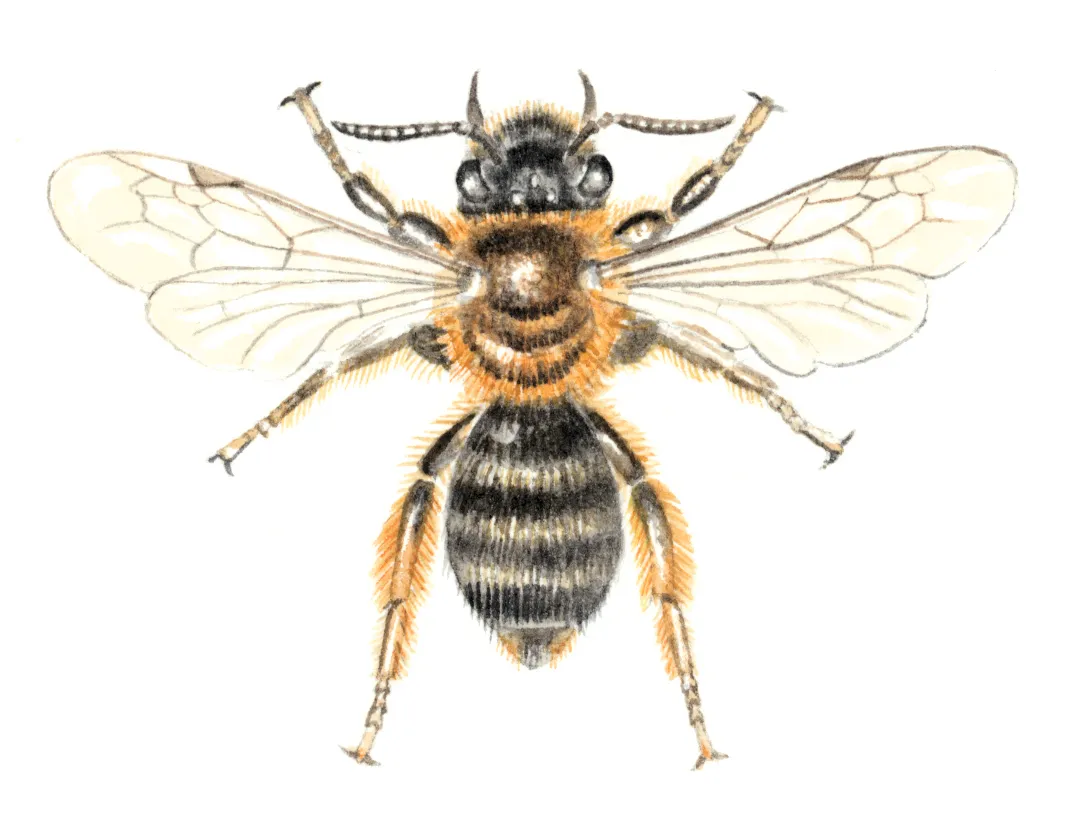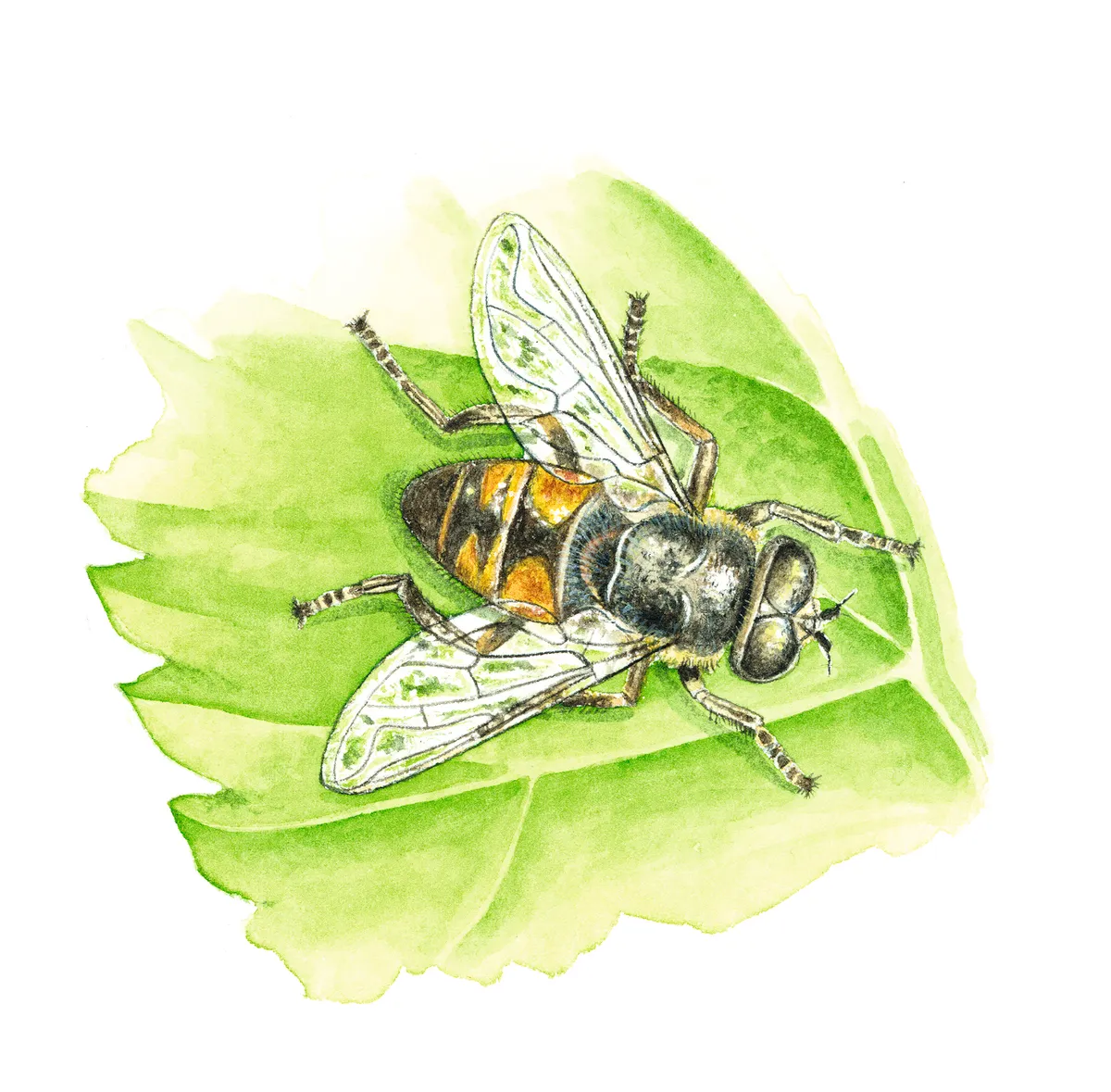Don't rely on swallows, chiffchaffs and cuckoos as harbingers of spring. You can spot many of the dozen early-emerging bees we've illustrated without even leaving your garden or local park. A few friends and I have a competition to see which of us spots the first hairy-footed flower bee visiting lungwort in our gardens, usually in the first days of March.
Insects that become active now, before the summer rush, can cash in on nectar and pollen from plants such as sallow (pussy willow), Mahonia and flowering currant. They include solitary bees such as Andrena bicolour and the beautiful tawny mining bee with its fiery coat.
Many of the solitary bees are short-lived - after mating and egg-laying they're gone before spring ends. But bumblebees are around for much longer. the founding queens we see now will go on to produce broods of workers, males and next year's queens. All five bumblebee species shown here can easily be seen this month.
All illustrations by Felicity Rose Cole
White-tailed bumblebee, queen (Bombus lucorum)

Often the earliest active bumblebee, the white-tailed bee can be confused with the buff-tailed bumblebee (below), and the workers of both species are identical. The queen is medium-sized with single yellow bands on thorax and abdomen and white tail.
The bees can be seen from March to October, but only some social classes are present at each time, with queens present first and staying the longest. In April, workers first appear. Nests are built underground, usually in discarded mammal burrows.
In upland and exposed coastline habitats the white-tailed bee is usually outcompeted by other Bombus species. They love brambles, umbellifers, sallows, thistles, and knapweeds.
Buff-tailed bumblebee, queen (Bombus terrestris)

Large and dark; single yellow bands on thorax and abdomen; buffish tail.
The species is around from February to October over two generations, and sometimes a third generation, active over the winter, is able to thrive.
Gorses and fruit trees and shrubs are some favourite forages for this bee. They nest underground in old mouse nests, or in grass, and are at home in residential areas.
Tree bumblebee, queen (Bombus hypnorum)

Arriving in the UK in 2000 and now abundant in gardens, the earliest castes appear in march and the bees are present until September.
It is medium-sized with a ginger thorax, black body and white tail.
They prefer land with a bit of foliage, rather than bare ground. They are fond of foraging on sallows, bramble, and rhodedendrons. Nesting in bird nestboxes, or in roofs, colonies can grow to a modest 150 individuals.
Early bumblebee, queen (Bombus pratorum)

This species is small for a bumblebee with a single yellow band on both the thorax and the abdomen, though the latter may be absent, and tapers to an orange tail.
From March to October, two generations persist and concentrate on dandelions, fruit trees, rhododendrons and dead nettles. The bees are happy to nest up high, or underground, utilising vacated rodent dwellings, or tree trunks.
Red-tailed bumblebee, queen (Bombus lapidarius)

The bees are large and dark, with fiery orange tail, and are usually active from March to August.
They love white clover, and often enjoy habitats in fields of the plant, however, they can live happily both in developed and countryside areas. Likes flowers such as dandelion, and white and red dead-nettles. The bees nest underground and are widespread throughout Britain.
Gwynne's Mining Bee (Andrena bicolor)

These bees have two generations per season with little overlap, and can be seen from March to August. They are small, with an orange thorax. Unlike other bee species, mining bees generally do not exhibit as much social behaviour, living alone in individual dug burrows or only in small groups. There is also no queen serving as the reproductive caste. The way mining bees live is more like a commune, where some resources are shared, but individuals raise their own young.
Gwynne’s mining bee is comfortable in a large range of habitats, but prefers sunny areas and dislikes high altitudes. In the spring, the bees feed from horse, dandelions, forget-me-nots and garden flowers.
Tawny mining bee (Andrena fulva)

From March to June, the tawny mining bee enjoys spring shrubs, including willow, hawthorne and fruit trees, as well as dandelions. The bees generally nest near people, on footpaths, parks or gardens, and are frequently seen excavating nest cambers there. As they are a mining bee, they nest underground, but form much larger groups than Gwynne’s mining bees.
The bees are solitary, and it is the female bee that exhibits the brilliant orange 'fur' pictured, appearing to glisten brightly in the sun.
Early mining bee (Andrena praecox)

Pussy-willow is a very important plant sustaining this medium-sized, brownish solitary bee. They can be seen from February to May. As such, the bees enjoy habitats close to willow, as well as brownfield sites and quarries, with a preference for soil rich in clay. The bees like willow catkins and will also visit grey willow and goat willow trees.
Males have a characteristic flight pattern, zig-zagging while ascending a tree trunk, possibly to examine the spot for potential female bees to mate with.
Clarke's mining bee (Andrena clarkella)

These large solitary bees have an orange thorax and orange-haired pollen sacs.
Clarke’s mining bees are found in very similar locations to early mining bees. They are at home in sandy spaces, like gravel pits. They are around as early as February until May. Many of the bees nest among the roots of a large tree, and enjoy sallow catkins and flowering shrubs.
Yellow-legged mining bee (Andrena flavipes)

The yellow-legged mining bee flies from march to September in two generations. It is a medium-sized solitary bee with white bands on abdomen and yellow hairs on pollen sacs. The bees thrive both inland and on the coast, at home in soft rock cliffs and in house gardens.
The bees are sustained largely by shrubs that flower in the spring, and enjoy composite, umbellifers and crucifers. The bees are happy on ground not populated by many plants, and nest in loose groups.
Red-tailed mason bee (Osmia bicolor)

A medium-sized, furry solitary bee with black thorax and bright red abdomen.
The bees appear from March to April, with females emerging a little later than males. The males are protective of empty snail shells, and will defend the prize within their foraging grounds. This is because nesting takes place in the shells, and sometimes several bee nests are present inside a single shell, which is camouflaged with ground litter.
The bees are very fond of chalk and limestone, preferring habitats with these fixtures.
Hairy-footed (feather-footed) flower bee (Anthophora plumipes)


Largish solitary bee. Female (top) is black while the male is gingery.
The bees can be seen from February to June, with females appearing later than males. They are at ease around people, and usually occur in areas of urban green space, like parks and gardens. Primroses, ground ivy, nettles and lungwort are favourite forages, and research has suggested that males are protective over their distinct patch of flowers.
The bees are comfortable nesting at vertical locations, such as cliffs and inside chimneys.
Some insects that may be confused for bees:
Dark-bordered bee-fly (Bombylius major)

The most common and widespread of the bee-fly species. It has a ginger body, a dark border on the leading edge of its wings (hence it's name, and a key feature for separating it from the dotted bee-fly), and a long proboscis. It lays its eggs in the nests of solitary bees.
Drone fly (Eristalis pertinax)

Many of the hoverflies are bee or wasp mimics. This species is a honeybee mimic. On warm days it hovers in mid-air, just above head height, and basks on leaves.
How to get involved
- Attract early-emerging bees by planting lungwort, flowering currant, Mahonia and spring-blooming varieties of Viburnum.
- Stake out sallow blossom on a sunny March day to spot a wide variety of solitary bees and bumblebees. Use close-focusing binoculars to identify them.
- Send your records to the Bees, Wasps & Ants Recording Society (the website also features excellent ID guides), or the Bumblebee Conservation Trust.